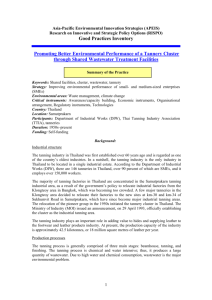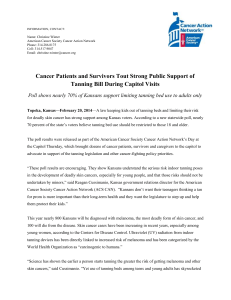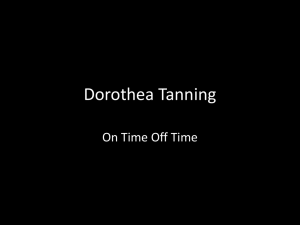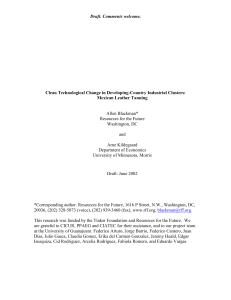Peru : Clean Processes and Technologies to support Small Industries
advertisement
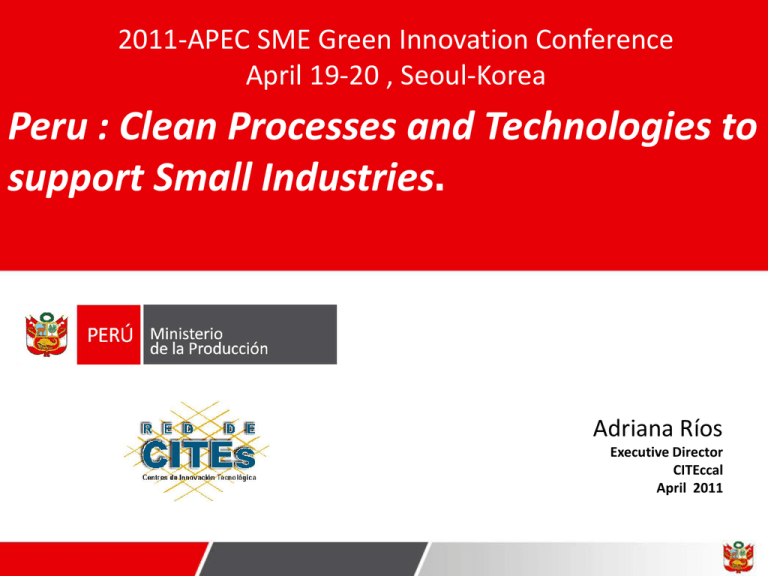
2011-APEC SME Green Innovation Conference April 19-20 , Seoul-Korea Peru : Clean Processes and Technologies to support Small Industries. Adriana Ríos Executive Director CITEccal April 2011 Gross Domestic Product of Perú (US$ millions) Source: Central Reserve Bank of Peru Factors that contribute to the Competitiveness ASSETS: •GDP growth 2009 •Natural Resources and Mega biodiversity •Boom of exports •Geographic position •Inflation rates (less than 1% month). LIABILITIES: •Unemployment and poverty •Highly atomized businesses •Low Productivity levels Collection Stage Where is Perú in technological process? 2nd Industrial Revolution 1st Industrial Revolution Agriculture Strategic factor Competitive advantage Technology Information and Knowledge Intelectual Capital Machines Land Manufacturing Mindfacturin Biotechnology, Nanotechnology PERUVIAN SMEs Micro Enterprises Con Less than 5 persons 95,38% Between 5 10 persons 2,27% More than 10 persons. 2,34% DEFINITION • Micro: 15 workers • US$165,000 • Small: 50 workers • US$465,000 General Information • 97.65% are SMEs • SMEs represent 74% of national employment • Low productivity • Low added value • 60% subemployment Formal Peruvian SME are mostly dedicated to retail and wholesale activities. Distribution of Peruvian SMEs by Sector Agriculture 4,5% Manufacture 6,4% Services 34,4% Source: SUNAT, 2001 Building Others 1,3% Otros 0,5% Retail and Wholesale 52,9% Peruvian SMEs face a number of problems: Informality Underqualified Employees Low managerial capabilities Insufficient Information Lack of cooperation Low productivity Low competitiveness Low profitability Inadequate use of technology Financing problems The Future: An Industrial Policy oriented to an Added Value Export Model • Competitiveness and innovation culture. • Investment and technology. • Improving quality, management and innovation capability to access markets. • Environmental management . • Management skills. Strategic agreements • National Agreement: 31 Policies of State 19.- Sustainable development and environmental management. 20.- Development of science and technology www.acuerdonacional.gob.pe Ministry of Production Instruments to promote innovation: •Funds for Innovation (FIDECOM). •Network of Technological Innovation Centers (RED CITEs). Innovate Perú, FIDECOM • Research and Development Fund for Competitiveness. • It is a competitive fund (70 millions US$) and aims to co-finance up to 75% of the projects submitted by SMEs. • The range of cofinancing is from 100,000 to 300,000 US$ per project. • The fund started operations one year ago. http://www.innovateperu.pe/ Innovation Technological Centers - CITEs • Purpose: Access to technology and promote innovation • Market driven. • Promote regional development, productive chains and competitive clusters. • Agents of Technological Transference between enterprises and R&D institutions. • Active presence of the private sector in its conception and direction. • Integrated in a NETWORK - RED de CITEs. • Consolidation of the Network of CITEs Project – PRORED. http://www.cites.pe/cites/ Network of CITEs according to the descentralization process Iquitos: Piura: CITEAgroindustrial CITEfrutas tropicales y plantas medicinales. CITEforestal Lima: Pucallpa: CITEmadera: Mueble CITEccal: Cuero-Calzado CITE Logística GS1 CITEsoftware CITEconfecciones y diseño U.T CITEmadera Ica: CITEvidArequipa: CITEconfecciones El Taller, CITEagrondustrial CEPRORUI CITEtextil camélidos IPAC CITElagroalimentario Tacna: CITEagroindustrial Innovation Technological Centers - CITEs • Provide services to SMEs : Training Technical Advice Information (trends, fashion, technology) Laboratory services for quality control Design and development of products. Pilot Plants to demonstrate processes Research and development (in partnership with universities). Role and Services of CITEs Lab testing Promote the use of standards R&D+i projects Enterprise Product development Logistics management and ITC Value Chain Quality System Training Pilot Plants Technical Assistance Technical information and Technological watch M A R K E T Technological Transfer Productivity and Quality improvement R&D+i Innovation Technical Standards promotion: • • • • • • • • • • Wood and furniture (CITEmadera). Footwear and leather (CITEccal). Pisco, wine, wineyard and grape.(CITEvid). Alpaca fiber - textile (CITEtextil de camélidos IPAC)Arequipa. Mangoes(CITEagroindustrial – Piura) Algarrobina (CITEagroindustrial – Piura) Olive and olive oil (CITEagroindustrial Tacna) Camu camu (CITE frutas tropicales y Plantas medicinales de Loreto) fruits and pulp from Camu-camu. Pallets y logistics (CITE Logística GS1 Perú). R&D+i standards (OTCITs). CITEs Labs: Applying Standard ISO/IEC 17025 “this standard is used by laboratories in their management system for quality, administrative and technical operations” Technological Services of CITEccal Pattern Technical Information and fashion trends Laboratory testing for quality control Training in footwear and tannery 3D Design Technical Advice scaling of patterns by computer Quality System Implementation (Standard ISO/IEC 17025) in 5 CITEs laboratories. Selected Laboratories: •CITEccal-Lima. •CITEvid-Ica (wine, pisco and grapes). •CITEagroindustry- Piura. •CITEagroindustry- Tacna. •CITEmadera (wood and furniture). CITEccal: Innovation technological center for leather, footwear and related. •Accredited under ISO/IEC 17025, february 2011. (General requirements for the competence of testing and calibration laboratories) • Inter-laboratory proficiency test with: – INESCOP of Spain – CIATEC of México – SENAI- CETEPO of Brasil CITEccal gives support to tannery manufacturers • Leather tanning is the process of converting raw hides or skins into leather. • The SMEs of tannery industry in Perú need to improve their processes, technology, and knowledge to make a clean tannery. Tannery Industry: The process Unhairing Skin Tanning Pollution 70%-80% Effluents Solid waste Wastewater Air emissions RTE: Retanning, dyeing and grease Finishes Pollution 20%-30% Solid waste Air emissions Peruvian Tanning Industry • The footwear and leather industry constitutes and important industrial sector in Peru, employing more than 100,000 people. There are around 150 formal tanneries in Perú and it is estimated that there is a similar number of informal tanneries. • For most of the tanneries the drainage system is not always adequate for the large amount of effluents. There are also some tanneries that throw their effluents directly in superficial waters. • Furthermore the poor environmental standards in the tanning industry encourage the overuse of chemicals, which tend to increase the quality of waste coming from the leather industry. Peruvian Tanning Industry • The tanning industry in the Peruvian sector suffers from complex problems associated with: • Poor applied technologies in tanning processes • Lack of environmental awareness • Untrained workers • Huge generated amounts of wastes due to inefficient use of resources • Low export levels due to non-compliance with environmental requirements • Limited investment in the sector Trends in leather manufacturing Nowadays, leather manufacturers are under pressure from competence and while having to meet higher environmental standards to satisfy authorities regulations and the market itself: • Environmentally friendly products. • Metal-free or low levels of cadmium, mercury, lead, chromium VI, etc. • Use biodegradable ingredients. • Sophisticated products. CITEccal Project to help tanneries to reduce pollution by clean technologies in the Pilot Plant • In 2006 CITEccal developed a project to demonstrate and promote the use of clean technologies in the Peruvian tanneries creating a tanning pilot plant and a wastewater pre-treatment pilot plant. Some tests to measure important parameters of water were implemented at the laboratory to complement the project. • Other aims consisted in raising awareness on the needs and benefits of implementing environmental processes in the tanning production methods and overcoming all the problems related to environmental compliances, awareness raising and improving productivity. CITEccalTanning Pilot Plant • To research and develop high added value leathers Desarrollo de productos innovadores Reducción de contaminantes en el proceso de curtido Appropriate technologies to prevent contamination: • Since then, CITEccal has been teaching Peruvian tanneries more about environmental technologies related to tanning processes with the aim of introducing improvements within the sector through applying cleaner production techniques for: reducing water consumption, reducing salinity in wastewater, reducing generated amounts of wastewater and of solid wastes, recovering and recycling of the rejected materials and wastes, optimising the use of chemicals, substituting toxic materials and reducing toxic emissions and by-products valuation. • The application of these CP techniques have lead to both environmental and economical benefits. Processes to prevent pollution Recycling and treatment of wastewater from unhairing: recovering hair instead of disolving it Catalytic oxidation and aeration pool Solids separation Precipitation tank Sedimentation Acids wastewater pre-treatment: Chromium Chromium precipitation by using lime Results • Production costs minimization; • Quality improvement; • Applying new technologies in tanning and finishing processes; • Establishing new markets for Peruvian products; • Increasing added value; • Increasing productivity; • Help and advice to get Certification through environmental compliance; Thanks for your attention and if you go to Lima, Peru, please contact us. We are in 1300 Caquetá Ave. District of Rímac, Lima, Perú Our Phones: (51-1) 3820115 - (51-1) 4825870 email: citeccal@produce.gob.pe web: www.citeccal.com.pe Thanks! OTCIT Vice Ministry of SME and Industry 2011 April
